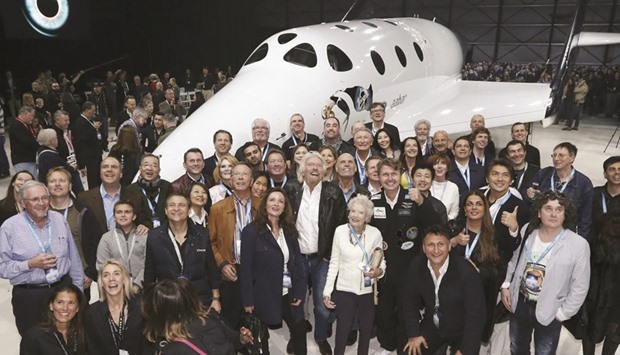Richard Branson’s Virgin Galactic venture unveiled a new passenger spacecraft on Friday, nearly 16 months after a fatal accident destroyed its sister ship during a test flight over California’s Mojave Desert.
The rollout of the gleaming craft, dubbed Virgin Space Ship Unity, marks Branson’s return to a race among rival billionaire entrepreneurs to develop a vehicle that can take thrill-seekers, researchers and commercial customers on short hops into space.
“It’s almost too good to be true,” Branson said during a ceremony at the Mojave Air and Space Port, about 160km north of Los Angeles. “When I saw it for the first time, it brought an immediate lump to my throat and tears to my eyes. It was a completely overwhelming moment.”
Christened with a bottle of milk by Branson’s year-old granddaughter, the ship was painted bright white on its front section, fading to grey and black toward the tail.
The tail itself was emblazoned with a blue image of a peering eye belonging to famed British physicist Stephen Hawking.
Branson has already offered a flight into space to Hawking, who is confined to a wheelchair and suffers from amyotrophic lateral sclerosis, or ALS. It was Hawking who suggested naming the ship Unity.
“I have always dreamed of spaceflight, but for so many years I thought it was just that - a dream,” Hawking said in a recorded message played at the space port. “If I am able to go, and if Richard will still take me, I will be proud to fly on this spaceship.”
From outward appearances, the spacecraft is nearly identical to the one lost on October 31, 2014. The accident was blamed on pilot error and oversights by Northrop Gumman Corp’s Scaled Composites division, which designed, built and tested the vehicle, known as SpaceShipTwo.
Virgin Galactic’s own manufacturing arm, The Spaceship Company, already was well into construction of the successor ship when the accident occurred.
The biggest difference between the two is the addition of a pin to prevent a pilot from unlocking the ship’s rotating tail section too soon before descent, which is what triggered the breakup of the first spaceship, said Galactic chief executive George Whitesides.
The two-pilot, six-passenger spaceship is designed to reach altitudes of 100km above the planet, providing a few minutes of weightlessness and a view of Earth set against the blackness of space.
Nearly 700 people have signed up for rides, which cost $250,000 each.
Friday’s unveiling set the stage for Unity’s first round of test flights. The company has declined to discuss a schedule, but Whitesides said he expects to rapidly repeat milestones the first craft achieved and then incrementally test the new ship at higher speeds and altitudes. The first spaceship had not yet travelled beyond the atmosphere.

Sir Richard Branson poses with his mother Eve and future astronauts after unveiling the new SpaceShipTwo in Mojave on Friday.


